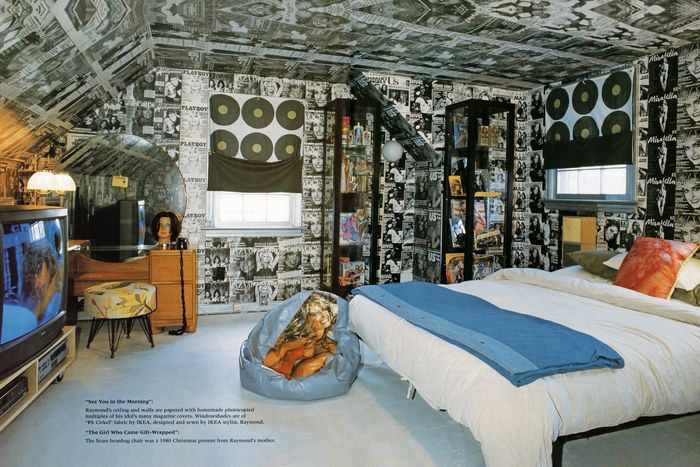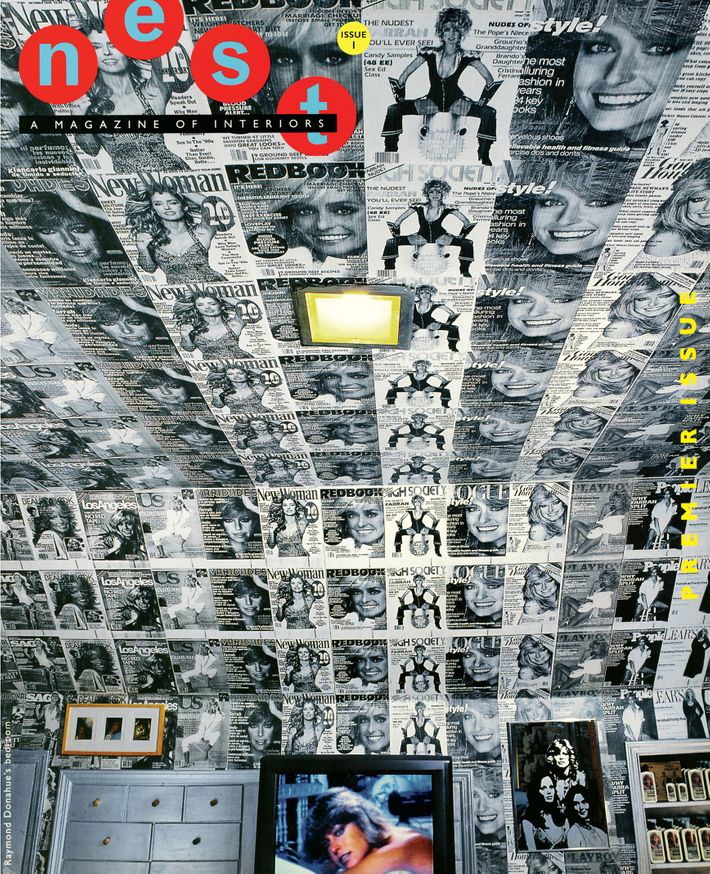
Nest called itself “a magazine of interiors,” but from the very first issue, it was clear that it would be far more adventuresome than other shelter magazines. The first cover featured a suburban New Jersey bedroom that had been turned into a shrine to Farrah Fawcett. A friend of Nest editor Joseph Holtzman had told him about the room, which was occupied by an Ikea showroom decorator, then in his early 30s, named Raymond Donahue, who had been obsessed with the actress since he was ten. The attic bedroom was in his mother’s house, and Donahue had created his own Fawcett wallpaper, inspired by Andy Warhol’s use of repetition, by photocopying magazine covers. The Nest story begins with a photo of Donahue’s neck tattoo, the bar code of Farrah Shampoo, by Fabergé. “I worship and idolize her,” he is quoted as saying. “If she died, I feel my life would be over.” Fawcett died in 2009 of cancer (the same day as Michael Jackson). Being on the cover of the magazine made Donahue a tiny bit famous for a time, but it didn’t change his life: He still works for Ikea, today as a freelance design specialist, and still lives in the same house, although he bought the half he lives in from his mother. He spoke to Curbed about how the design came about and what has become of it since.
How long had you been interested in Farrah Fawcett?
I’ve been collecting memorabilia on her since I was ten. That was 1975. So it was right before the cusp of when she blew up. And I had seen her in some ad or on a TV commercial. That was pre–Charlie’s Angels. I pulled out these Wella Balsam [shampoo] ads and other things when I had seen her, because she was very recognizable, or she was at least to me. And so I started collecting.
When I was young, like ten [to] 15, of course I had the poster on the wall and I had the clippings on the wall, and I didn’t get rid of it all. I was like, All right, I have my collection. I’m just going to have my collection put away. And then, as I got a little bit older, when I went to do the room, it was a bit more about, I have to think of a more interesting way to do it that’s not like your typical fan and how they would do it. And it just kind of stumbled into one wall, which then turned into a whole room.
And you made the wallpaper.
I made it at Ikea. I would bring a magazine and then I’d make a million copies of it and, you know, and then I’d do them. Ikea probably wouldn’t want to know that I was doing them, but whatever. It was 20 or so years ago.
How did you meet Joseph Holtzman?
I have a friend who is friends with Joe. And he had said to me, “Joe is looking for interesting interiors for this project that he’s doing. Just take some pictures and give it to me and I’ll give it to him.” And I was like, All right, whatever. I never, ever thought anything would come of this. So I took the pictures of the room; I gave it to my friend, who then gave it to Joe. I had only met Joe once, so I don’t know him at all. And then next thing I know, my friend says to me, “Joe wants to come to the house.”
Then what happened?
It was multiple visits, because they came the first time to do the shoot. It was like hours and hours. And I kept thinking, My God, how long could it take just to take pictures of this room, you know? And then they left.
And then a few weeks later, they got in contact with me, and they’re like, “We need to come back.” And I’m like, okay. Because of course I had the room a little bit styled, so I had to get all my clothes off the floor and whatever and just clean it up. And so they came back a second time, and they took more photos. What I didn’t know was the reason that they came back the second time: because they decided they wanted to put it on the cover. So they needed to come back, I guess, for that additional shot that they wanted to use for the cover. And I didn’t know that until the magazine was coming out. My friend knew, and he was like, “Oh, you’re going to love it. You’re going to love it. You’re going to love it.”
You didn’t know it was going to be the cover? How did you react?
It was a huge surprise to me. I had no idea. I think I got a copy in the mail. I was shocked. I knew it was going to be in the magazine, so that was no surprise. I was shocked that it was on the cover. To me, it makes a little bit of sense. Farrah, you know, even at that period, she was a huge star. And if you’re going to launch something — especially the type of magazine like Nest, which was about doing things a bit differently and not your typical interior — when you combine that with a celebrity, it just kind of made sense.
For a little while, there was a bit of like, “Your room was on the cover of that magazine,” when I would run into some people. Because, you know, word travels. I know people in Sweden, and they had found out about it and they contacted me — friends, you know, not just random other freelancers, but people I’m friends with. A little bit of that. But no, it didn’t change my life at all. Interesting things happened because of it. Like I was on MTV House of Style, for like the best bedroom of whatever year that was. There was a picture of the magazine in Wallpaper; at that point, I had loved Wallpaper magazine. So for the cover to be in Wallpaper was like, Oh wow, how cool.
Did you ever talk to Farrah Fawcett about it?
I had met Farrah many, many, many times. And the one time I went to go see her at something, we actually got to talk about the magazine. And she was like, “Oh, that’s your bedroom.” So I think that was probably the most impactful thing about the whole thing, her knowing about it and me being able to conversate with her something more about just being a fan. It took it maybe to a different level, which was nice. Even just the fact that she knew about it. And remembered. I mean, you know, with celebrities, they come in contact with so many people.
It must have been tough when she died.
[Her death] was sad. It’s like, when there’s something that you enjoy in life or somebody that you, I guess for lack of a better word, idolize — especially from such a young age, being a fan from ten years old — I think anybody would experience that. I don’t really know how to explain it, but yeah, there is a sense of sadness. It’s also the fact of you never get to see anything new from that person again, or any interview that you will ever see on TV is going to be of an interview that you’ve seen before. The loss of knowing that there will never be nothing else.
You’re still in the house?
I’m still in the home. A few years back — my mother still owns half of the house — I bought the other half of the house, and when I bought the house, what I did was I did a huge renovation on the whole thing, and so the upstairs now is like a big, full, complete apartment. To do something like that, you totally have to renovate the whole house. So along with the renovation came complete demolition. I looked at it as with anything else with a new house, a new move, a new interior. When it came down, for a little bit of time, I saved a piece of the wallpaper and thought, Maybe I could sell this on eBay. Maybe somebody will want this. But no. For me, it was nice to have a fresh new palette.
What’s it like now?
The walls are just white. That’s all I like. I don’t want to have any color. When it comes to furniture, I really like mid-century, so I’m always finding something. The furniture pieces kind of evolve, but I think I’ve had a very solid core base of what I really like in the spaces. So it’s just the little things that are changing. You know, like the chairs around the table, just stuff like that. Right now, I only have three [Fawcett] things out, and that is absolutely it.
I actually have a large poster of the magazine cover. When the wallpaper went, this came. It’s hanging in my bedroom. And when she did the play in 1983, I actually have the billboard from the theater. It’s this huge billboard. So I have to have it out only because I have no place to store it. And then I have an original piece of her artwork. She was an artist. That was her first love. It’s two faces looking at each other, and they kind of intertwine in the face. It’s very modern, and so it fits with my style aesthetic. And, you know, it’s the pop of color on this white palette of all the walls, so it’s really beautiful.
There’s one interesting thing that always stands out in my mind, which is I was out on a street somewhere in New York, and I go into a store and somebody, like, recognized me — which I found so, so bizarre — because I don’t know, I guess he was a fan of Nest magazine or something like that. I guess he must have been into interiors or something, and I walked into the store and he was like looking at me. And I’m like, “Hey, what’s going on here?” And then he said to me, “Were you in that magazine?” And I was like, Oh God. It was kind of weird, you know. Maybe that’s my little bit of celebri— celebridom, or whatever you call it.







